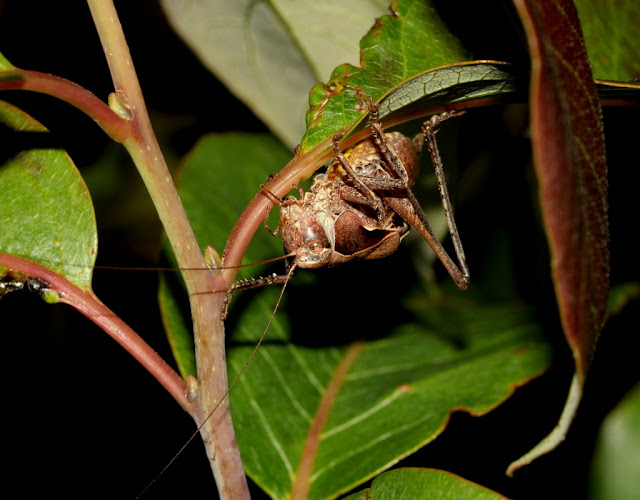The Protean Shieldback. That’s truly the name of this armored tank of a katydid. If you saw one, you probably would not even think it
IS a katydid, and you’d certainly never guess that it’s a little predator.
Shieldbacks are almost always brown, which is appropriate
for their habitat. They live at woodland edges and shrubby fields, climbing up
onto shrubs and other vegetation after dark. They look carved from wood - even the female's ovipositor!
Underneath (if you get the opportunity to look), you'll find a rich, contrasting yellow.
Why are they called shieldbacks? Take a closer look. Doesn’t that appear to be a little shield?
And those bodies! They certainly don’t resemble the long-winged
Scudderia bush katydids, like this Curve-tailed Bush Katydid on a nearby leaf.
In fact, it’s hard to imagine how the males can make enough
sound to be heard with those little wings projecting from below the shield, but they certainly manage quite
well.
Here’s the Protean Shieldback's song:
There are three shieldback katydid species in Ohio, and I
suspect the Protean is the more common. Up here in NE Ohio, we seem to be more
likely to find Least Shieldbacks, though they occur elsewhere in the state as
well. They look similar and I don’t think there’s anything “least” about them. The
American Shieldback’s range map indicates that they could be found in southern
Ohio.
The Least Shieldback’s song is a series of short little
bursts that occur in a consistent rhythmic pattern:
In contrast, the Protean Shieldback’s song is longer, with brief pauses between songs. (Far below the Protean Shieldback, you'll see the songs of Cope's Gray Treefrogs, which are present in southern Ohio, but not in NE Ohio.)
The songs are not necessarily consistent in length; the songs of the Least Shieldback are more rhythmic and predictable. Because this is the one shieldback species that has a song with long phrases and very short pauses, it’s rather easy to identify.
The only song I have to listen closely for is the Rattler Round-winged
Katydid. The Rattler's songs are both short and long phrases, and are often two short bursts followed by a much longer phrase.
When I play them in isolation, there’s no confusion, but when a number of katydids are singing in the meadow or edges, songs can overlap and cause some confusion. I try to focus on the different tone quality of the Rattler Round-winged.
Were
they singing in the same habitat? Of course – at times they were almost next to
each other!
We have one other shieldback that is common in NE Ohio,
though I don’t know how far south this little non-native species has traveled.
I wrote about Roesel’s Katydids a couple of years ago, and you can read about
them here. They are varying degrees of brown and green, and look quite different from
our big, burly native shieldbacks.
As we did last year, Wendy and I have been visiting Buzzards Roost Nature Preserve in the Ross County Park District near Chillicothe in southern
Ohio, and delighting both the gorgeous preserve and the singing insects that we
don’t have up in the Cleveland area.
Protean Shieldbacks can easily be found
there from at least June 22 into July. On our most recent trip over the July 4th
weekend, we saw quite a few. It’s was quite unlikely that we’d see them during the day.
After dark, however, they suddenly appeared.
Although it was very challenging to manipulate both my body and camera to photograph them in the dense vegetation, sometimes the shieldbacks themselves were in convoluted positions. This mating pair's balancing act
didn’t even look possible, especially for two hefty, chunky insects!
The most fascinating part of the evening was finally seeing an example
of their predatory behavior, which I'd read about but never observed. Many
katydids will eat an occasional small insect if the opportunity presents itself
– I once saw a Short-winged Meadow Katydid eating a damselfly – but shieldbacks
are hunters.
At first, I thought this female Protean Shieldback on the
same leaf as two mating Japanese beetles was just passing
through.
I thought it looked a little crowded on that leaf until I realized
why she really was there:
She was planning her dinner!
Only once have I heard and seen Protean Shieldbacks in NE Ohio, but I know it's a possibility. I've only found Least Shieldbacks a few times over the years, too. Still, I'll keep listening and looking every summer, and I know I can visit them in southern Ohio.

















Great post, Lisa. Protean shieldbacks are fairly common in NE Illinois, but this year I realized that their season here is very short, perhaps 3 weeks only. Haven't found least shieldbacks, yet, perhaps you can advise me. Protean shieldbacks had a huge year here in 2007, when they feasted on periodical cicadas.
ReplyDeleteThis is fascinating. I don't think I have heard these insects here before. I am not out too much at night though. I am happy to think there is something other than Cardinals eating Japanese beetles.
ReplyDeleteThank you for your awesome website!!! I just found it today and I am thrilled! Came across it while doing a Google search of the angle wing katydid sound. I am highly intrigued with the beautiful sounds of nature. Finding you and your site has been an instant love connection! Keep up the excellent work! I have bookmarked your website and subscribed to get updates. Heading off now to play catch up on other posts within your site.
ReplyDeleteMany blessings to you and family!
Warmly,
~Jacqueline